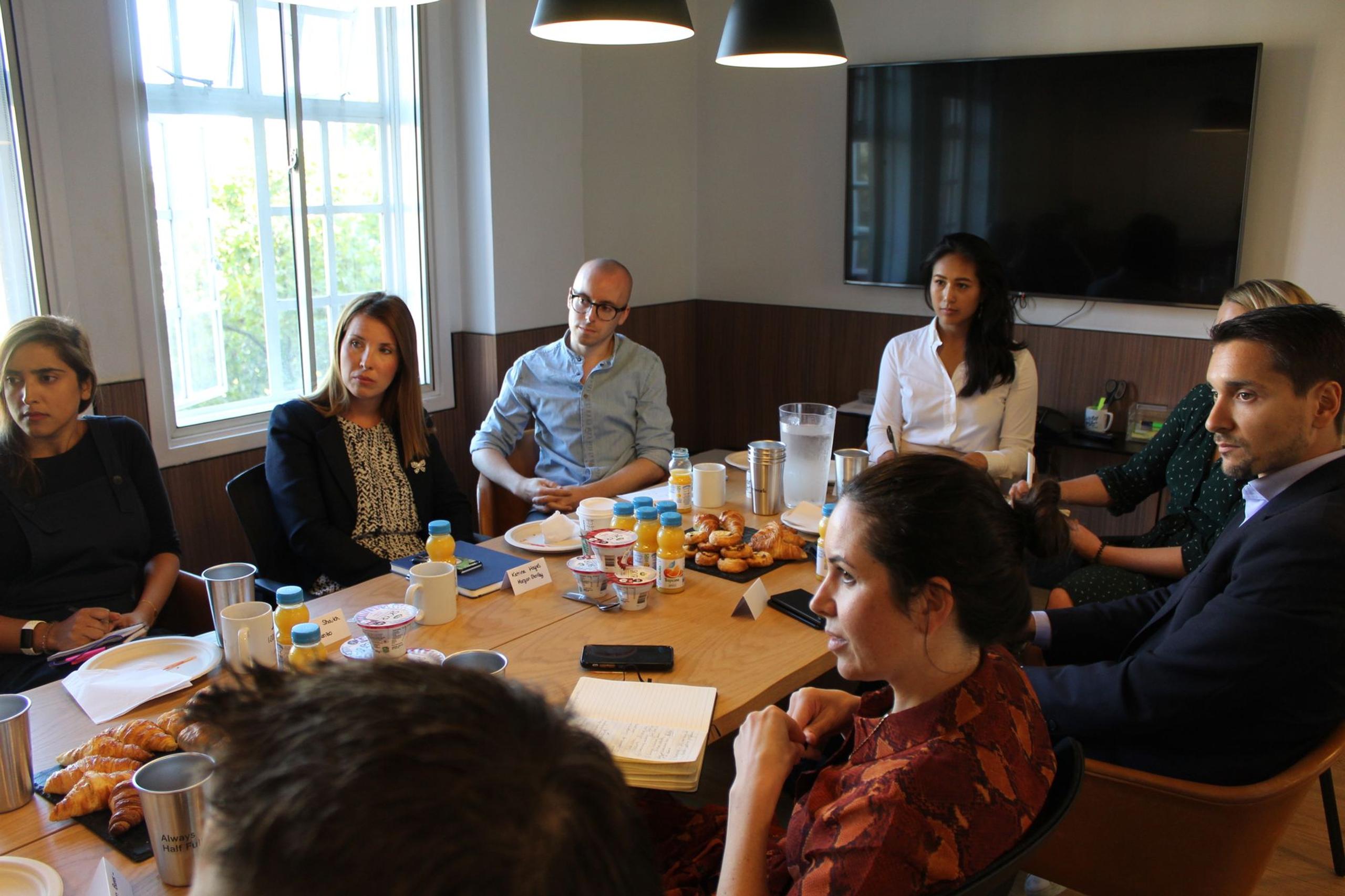On Tuesday 17th September, we hosted a number of HR representatives and diversity champions in the finance industry at our offices. Part of a series of events designed to facilitate industry-specific conversations and knowledge sharing amongst peers, we were joined by HR representatives from Investec, Monzo, Morgan Stanley, tide, HSBC, TransferWise and Julius Baer for our Diversity in Finance roundtable breakfast.
The morning kicked off with introductions, with each attendee highlighting their biggest challenge, setting the scene for what was to come. One of our guests described his biggest challenge as balancing diversity initiatives with corporate needs whilst another wanted to discover more about the progressive things they could do to reach an untapped market and how they could prevent burnout and enable progression. Along these lines, two were both interested in discussing how to address other diversity factors, instead of just looking at gender, and how to reach people from a lower socioeconomic background. One focused on the importance of a culture of inclusion and belonging; one wanted to hear what metrics people looked at and how they measure progress on initiatives, especially looking at what you can do when you aren’t in hiring mode; and another raised the challenge of moving diversity from common sense to common practice.
Key areas we covered:
Measuring diversity
“Stats are crucial for helping to track progress and setting targets”
When measuring diversity, you need to start by collecting data. For new hires, this is relatively simple; you can include an equal opportunities form during the application process with wording explaining how the data would be collected and used. Not foolproof, as one of the answers is ‘would prefer not to say,’ but a good starting point. Getting data on your existing employee population is a little more difficult as often individuals don’t see this as a priority. Something one of the attendees found worked was being really transparent in how they communicated what they were doing, and why they were doing it. Another shared how he ran a quarterly engagement survey to 25% of the population where they were asked if they consider themselves to be a minority. An added benefit, he said, was that they received frequent feedback on the policies, processes and environment.
A key barrier here, raised by one of our attendees, is that there are differences in opinion; ‘what you may define as BAME, is not necessarily how someone would classify themselves.’
Businesses have to be realistic in their approach. When setting targets, you need to look at the breakdown from universities and the population in general to make sure they are realistic - otherwise you are fighting a losing battle.
Stakeholder buy-in
“I didn’t ask for permission”
One of our attendees speaks honestly about the fact she didn’t ask for permission, instead doing and asking for forgiveness later and having frank discussions with leadership.
For those less brave, the suggestion was to create a business case. There is a lot of research on diverse leadership and how companies with a diverse leadership team are performing better; you can use some of the data shared in these to form the basis of your business case. One attendee added ‘getting buy in, sharing data and conducting research is a great way to overcome different views from those more senior than you.’
As a way of getting internal buy-in specifically for apprenticeships, one attendee, aware that her department is very visible within the company, hired an HR apprentice into her team. By showing off how capable her apprentice was, and making sure others in the company had visibility on the work they were doing, she created a ‘poster child for apprentices’ within the organisation.
Diversity committees and networks
“An enclave doesn’t solve the problem”
Diversity committees and networks are by no means the same, but they both enable open communication about issues with leadership.
One of the companies in attendance told us they have a diversity action council made up of MDs across the business to help them get senior stakeholders that will fight for them. Having the CEO or a board member on the committee was highlighted as beneficial, along with finding advocates and champions internally, as they will be able to bring your ideas to the table in executive meetings and act for you.
Networks are another way of bringing a collective voice to leadership. It’s crucial, when introducing networks, to make sure they become inclusive and providing educational content, creating a level of understanding. If you don’t challenge the individuals leading the network to create this educational conversation, then you risk it becoming an enclave which doesn’t solve the problem either.
“Diversity supports business”
One attendee reflects how they have started to publish their diversity & inclusion data so have visibility on where they are falling down but, because they are at a stage of huge growth (hiring over 200 people across 2 sites this year) and are focusing on hitting the revenues they promised, he is finding it difficult to balance diversity with business demands. Another compares how it took them 4 years to hire a diversity & inclusion person, and that it was their company mission that helped create the business case. With a mission to ‘make money right for everyone,’ they needed their employees to represent their customer base, and that included their diverse customers.
This led onto whether anyone in the room had experience push back from clients, or indeed lost business, because of their diversity and inclusion stats. One of the attendees tells everyone that they now feed their metrics and talent initiatives into pitch materials, whilst another refers to an initiative, HealthyHER, that their company have and how talking about it to clients has helped them.
Employer branding and job descriptions
"When you are creating a job posting, you are asking for a superhuman"
The language used to communicate your company benefits, or in your job descriptions, can have a huge impact on the number of candidates that apply. Whether it is using words that are more attractive to men than women, or if you appear to be asking for a ‘superhuman’ where you’ll only attract those with the biggest egos, you’ll close the role off to talent.
One of our attendees tells about a time when they hired an agency to feedback on their recruitment campaign once. The feedback was that ‘the language used reflected that of a Shakespearean book,’ ultimately reducing the number of applicants because they didn’t understand the role.
Two strategies one attendee found that worked quite well were, when hiring a female engineer, they asked a female engineer to write the job description to get the tone right. The other was to have a chunky D&I statement at the end of their job descriptions. Whilst initially there was a lot of push back, they were able to show the range of candidates attracted as a result. One attendee talked about how, as a bank, they were heavily governed so they were testing storytelling as a way of removing the corporate spiel that candidates didn’t want to hear.
Talent pipeline
“Stop using the excuse ‘I can’t get the talent’ - push back and drive expectations"
One thing everyone agreed on was the fact that universities are struggling to attract talent. And, without the pipeline of talent coming from universities, it was important to build your own pipeline of talent. There’s a break between education and industry, so industries need to take it upon themselves and actively go into schools to talk about the opportunities available, offer CV building and interview practice, and find a way of educating people at school to help solve the problem earlier.
The cost of university is prohibitive, so you need to challenge whether a degree is actually a requirement for the role on offer. Once someone has more than a few years experience, it’s not something you look at, so should it be in the beginning?

